|
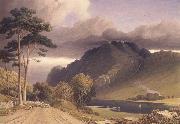 |
George Fennel Robson
|
|
English Painter, 1788-1833
English watercolourist. After initial training in Durham, Robson moved to London in 1804 with the intention of becoming a landscape painter. He was introduced to the circle of artists surrounding John Varley, and it was from Varley that Robson derived the strong, uncluttered compositions and breadth of manner that characterize his own style. |
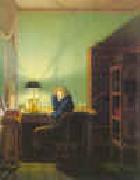 |
Georg Friedrich Kersting
|
|
1785-1847
German
Georg Friedrich Kersting Gallery
Kersting was a friend of Caspar David Friedrich, the leading German Romantic painter; his style was influenced by Friedrich, and he shared that artist's romantic attitude, although in a more subjective manner. The two friends went on a walking tour of the Riesengebirge in 1810. During his many hikes with Friedrich, the two painted numerous sketches and observations from nature. He may have painted the staffage in some of Friedrich's early work??such as Morning in the Riesengebirge (1810?C11), a result of their walking tour.
He was also a friend of the painter Louise Seidler, who described him as "an altogether splendid and comical fellow" and often served as his model. In 1813 Seidler helped Kersting send a number of his works to Johann Wolfgang von Goethe. Goethe was impressed and recommended that the Grand Duke Charles Augustus purchase his work The Embroiderer.
Kersting's most lasting works are his figures in interiors that borrow from seventeenth-century Dutch genre painting. These paintings nevertheless feel contemporary due to the situations depicted and the effect of the artist's personality. The characters are often viewed from the back, as in Friedrich's work, and the scenes provide hints of narrative as the figures engage privately in everyday activities. A number of his works refer to his time in the volunteer corps, the "L??tzow rangers". He drew a full-length self-portrait in 1813, in which he wore the rangers' uniform. The painting On Sentry Duty (1815) depicts three rangers, including the artist Ferdinand Hartmann and the writer Theodor Körner, who fought with Kersting and died in wars against the French. |
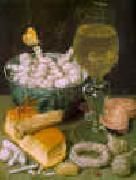 |
Georg Flegel
|
|
1566-1638
Georg Flegel Location
German painter. He was the son of a shoemaker, and not being a Roman Catholic, probably moved to Vienna after 1580, when the Counter-Reformation began to take effect in Olmetz. In Vienna he became the assistant of Lucas van Valckenborch I, whom he subsequently followed to Frankfurt, then an important centre for art dealing and publishing. He filled in staffage in van Valckenborch pictures of the seasons and portraits, inserting fruit, table utensils and flowers as still-life set pieces. His faithful reproduction of flowers and fruit drew on watercolours by Derer, still-life painters from the Netherlands living in Frankfurt, and botanical and zoological illustrations by Joris Hoefnagel, Pieter van der Borcht IV and Carolus Clusius (1525-1609) then being published in Frankfurt. |
 |
Gentile da Fabriano
|
|
Fabriano ca 1370-Rome 1427
Italian painter, one of the outstanding exponents of the elegant international Gothic style. In 1409 he worked in the Doge's Palace, Venice, painting historical frescoes that subsequently perished. In 1422 he was in Florence where he created his most celebrated painting, the resplendent Strozzi altarpiece (Uffizi). Gentile painted in the spirit and the manner of the older school, with glowing color and lavish use of gilt, thereby achieving a jewellike, courtly style. By 1425 he had responded to the new Florentine realism. His refined forms yielded to a sturdier rendering of figures in the Quaratesi altarpiece (panels are now in the Uffizi; Vatican; National Gall., London; and National Gall. of Art, Washington, D.C.). From 1425 until his death he worked in Siena, Orvieto, and Rome. Gentile died in Rome before the completion of the frescoes of St. John the Baptist in the Lateran Basilica. |
 |
Gentile da Fabriano
|
|
1370-1427
Italian
Gentile da Fabriano Locations
Gentile da Fabriano, whose real name was Gentile di Niccolo di Giovanni di Massio, came from Fabriano in the Marches. According to tradition, his family was an old one and moderately prosperous. His father, who was said to have been a scholar, mathematician, and astrologer, became an Olivetan monk when a monastery of that order was established in Fabriano in 1397. Gentile brother, Ludovico, was a monk of the same order in Fabriano, and Gentile himself was living in the Olivetan monastery of S. Maria Nuova in Rome at the time of his death. A document of Oct. 14, 1427, speaks of him as dead.
Gentile art indicates that he was probably trained in Lombardy, perhaps in Milan. He worked in the then current International Gothic style, to which he brought his own personal quality. His earliest works display the decorative rhythmic drapery patterns preferred by the International Gothic masters, which Gentile tempered and ultimately abandoned after his contact with Florentine art.
In a document of 1408 Gentile is recorded in Venice, where he painted an altarpiece (now lost) for Francesco Amadi. Testifying to his high reputation was his commission in 1409 for frescoes in the Doges Palace in Venice (painted over in 1479). Pandolfo Malatesta commissioned Gentile to decorate a chapel (destroyed) in Brescia in 1414. The artist is last recorded in Brescia on Sept. 18, 1419, when he departed for Rome to answer the summons of Pope Martin V. Gentile name first appeared on the roll of painters in Florence in 1421. He was in Siena in 1420 and 1424-1425 and in Orvieto late in 1425. From 1426 until the time of his death he was in Rome.
Typical of Gentile early style is the polyptych (ca. 1400) from the convent of Valle Romita in Fabriano, in which Gentile displays the International Gothic love for naturalistic detail in the floral turf beneath the feet of the graceful, slender saints whose figures are swathed in rhythmic, linear drapery. The central panel, the Coronation of the Virgin, shows the love for calligraphic drapery so characteristic of Gentile early style. Other noteworthy early works include the much damaged Madonna in Perugia and the Madonna with Saints and Donor in Berlin.
The altarpiece Adoration of the Magi, signed and dated 1423, was Gentile major work in Florence. In remarkably good condition, with its original frame still intact, it shows Gentile Gothicism now tempered by his contact with the more austere art of Florence. The rich display of gold leaf and brilliant colors were favorite International Gothic traits, but in the interest in perspective and foreshortening and especially in the exquisite predella panels Gentile shows the influence of the Florentines.
The altarpiece for the Quaratesi family, signed and dated 1425, also demonstrates the composite quality of Gentile art. The fresco Madonna Enthroned in Orvieto Cathedral of late 1425 has few traces of the International Gothic style and displays a corporeality and fullness in keeping with his evolution after Florence. His last works, the frescoes in St. John Lateran in Rome depicting the life of John the Baptist and grisaille portraits of saints, were destroyed in 1647, when Francesco Borromini reconstructed the interior. |
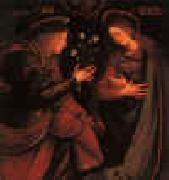 |
Gaudenzio Ferrari
|
|
1741-1546
Italian
Gaudenzio Ferrari Location
Italian painter and sculptor. He probably received his training at Varallo at the beginning of the 1490s, a lively period in the town artistic life, when extensive works were being carried out at the sacromonte. His master was Gian Stefano Scotto ( fl 1508), none of whose works has as yet been identified but who, judging from the early work of his pupil, may have been influenced by Lombard artists. Gaudenzio early works, such as a painting on panel of the Crucifixion (Varallo, Mus. Civ. Pietro Calderini), were influenced by the poetic art of Bramantino and by the northern Italian classicizing style of the Milanese painter Bernardo Zenale. His early, but self-assured, Angel of the Annunciation (c. 1500; Vercelli, Mus. Civ. Borgogna), painted for the Convento delle Grazie, Vercelli, suggests that these sources were soon enriched by his response to the tender Renaissance style of Pietro Perugino (active at the Certosa di Pavia, 1496-9). Gaudenzio is also recorded at Vercelli in the first known documentary reference to him, the contract for a polyptych commissioned by the Confraternit? di Sant Anna in 1508, with Eusebio Ferrari acting as guarantor. There remain four paintings of scenes from the Life of St Anne and God the Father (Turin, Gal. Sabauda) and two of the Annunciation (London, N.G.). In these works Gaudenzio style is more controlled, possibly as a result of a journey to central Italy in c. 1505. |
 |
Gallego,Fernando
|
|
Fernando Gallego (c. 1440 - 1507) was a Spanish painter, brought up in an age of gothic style, his art is generally regarded as Hispano-Flemish style. It's thought that he was born in Salamanca, Spain, and his first known works were in the cathedrals of Plasencia and Coria, in Ceeres (Spain). His most famous known works are:
The Retablo of San Ildefonso, in the Cathedral of Zamora, Spain
The Sky of Salamanca, in the University of Salamanca, Spain
The Retablo of Ciudad Rodrigo, now at the University of Arizona, Arizona, USA
The Arcenillas' panels, placed in Zamora, Spain
San Acacio and the 10,000 Martyrs, at the Meadows Museum, Dallas, Texas, USA
The last time that he was named in a document is in 1507, but the date of his death is unknown.
|
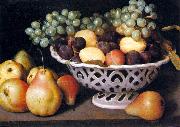 |
Galizia,Fede
|
|
Fede Galizia (1578 - 1630) was an Italian Renaissance painter, a pioneer of the still life genre.
|
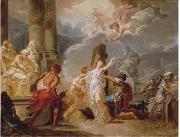 |
Gabriel-Francois Doyen
|
|
(1726 - 5 June 1806) was a French painter, who was born at Paris.
His passion for art prevailed over his father's wish, and he became in his twelfth year a pupil of Charles-Andra van Loo. Making rapid progress, he obtained at twenty the Grand Prix, and in 1748 set out for Rome. He studied the works of Annibale Carracci, Pietro Berrettini da Cortona, Giulio Romano and Michelangelo, then visited Naples, Venice, Bologna and other Italian cities, and in 1755 returned to Paris. At first unappreciated and disparaged, he resolved by one grand effort to achieve a reputation, and in 1758 he exhibited his Death of Virginia. It was completely successful, and procured him admission to the Acad??mie Royale de Peinture et de Sculpture. Among his greatest works are reckoned the Miracle des Ardents, painted for the church of St Genevieve at St Roch (1767)this painting was exhibited in the salon of 1767 which was recorded by Saint-Aubin in "View of the salon of 1767"; the Triumph of Thetis, for the chapel of the Invalides; and the Death of St Louis, for the chapel of the Military School. In 1776 he was appointed professor at the Academy. Soon after the beginning of the French Revolution he accepted the invitation of Catherine II of Russia. and settled at St Petersburg, where he was loaded with honors and rewards. He died there on 5 June 1806.
|
 |
G. Fuchs
|
|
painted Bolle Willum Luxdorph in 1782(1782)
|
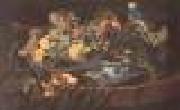 |
FYT, Jan
|
|
Flemish Baroque Era Painter, 1611-1661
Flemish painter, draughtsman and etcher. He was apprenticed in Antwerp in 1621-2 to Hans van den Berch [Berghe] (not to be confused with Jan van den Bergh of Alkmaar) and probably completed his training with Frans Snyders. In 1629-30 Fyt became a master in the Antwerp Guild of St Luke, but he continued to work for Snyders until 1631. In 1633 and 1634 he was in Paris. According to his biographers, he then went to Italy; an Italian journey is confirmed by the fact that in 1650 he joined the Antwerp Guild of Romanists (exclusive to those who had visited Rome), of which he became the dean in 1652. He apparently worked in Rome, where he joined the Schildersbent and was given the nickname 'Goudvink' (Dut.: 'goldfinch'). In Venice, according to Orlandi, Fyt worked for the Sagredo and Contarini families. He is also thought to have visited Naples, Florence and Genoa, and Orlandi stated that he also went to Spain and London. By 5 September 1641 Fyt was back in Antwerp, where, apart from a brief trip to the northern Netherlands in 1642, he apparently remained for the rest of his career.
|
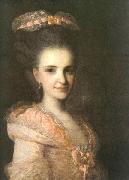 |
Fyodor Rokotov
|
|
(1736 - 1809) was a distinguished Russian painter who specialized in portraits.
Fyodor Rokotov was born into a family of peasant serfs, belonging to the Repnins. Much in his biography is obscure. He studied art in Saint Petersburg Academy of Arts. After buying back his freedom in the end of 1750s he became established as a fashionable painter.
In 1765, Rokotov was elected an Academician, but he did not work as a professor in the Academy long, because it interfered with his painting. He returned to Moscow in 1765, where he lived for the rest of his life. He had a lot of commissions there, becoming one of the best portrait painters of his time.
Among his best-known portraits are Portrait of Alexandra Struyskaya (1772), sometimes called the Russian Mona Lisa and admittedly the most celebrated piece of the 18th-century Russian painting; Portrait of Countess Elisabeth Santi (1785), and Lady in a Pink Dress. |
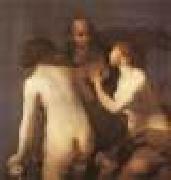 |
FURINI, Francesco
|
|
Italian Baroque Era Painter, 1603-1646
Italian painter. He was one of the leading Florentine painters of the first half of the 17th century, famous for the ambiguous sensuality and sfumato effects of his many paintings of female nudes. He first studied with his father, Filippo Furini, nicknamed Pippo Sciamerone and described by Baldinucci as a portrait painter, and he completed his apprenticeship in the studios of Domenico Passignano and of Giovanni Bilivert. Inspired by an admiration for Classical sculpture, which he studied in the Medici collection in Florence, and for Raphael, he travelled to Rome, which he reached as early as 1619 (Gantelli, see 1972 exh. cat.). Here he came into contact with Bartolomeo Manfredi and with Giovanni da San Giovanni. In 1623 he assisted the latter on the frescoes of the Chariot of the Night in the Palazzo Bentivoglio (now Pallavicini-Rospigliosi), commissioned by Cardinal Guido Bentivoglio, and also perhaps on the lower paintings (1623-4) in the apse of the church of SS Quattro Coronati, Rome. |
 |
Fritz Zuber-Buhler
|
|
was a Swiss painter integrant of the style Academic Classicism, born in 1822 at Le Locle in Switzerland and died November 23, 1896.
At sixteen years old he moved to Paris, France where found his first teacher Louis Grosclaude. Later he studied at the École des Beaux-Arts and then refined his technical skills with François-Édouard Picot, who followed the same lineage of contemporaneous artists such as Leon Perrault, Bouguereau, Alexandre Cabanel and many others. Afterwards he spent some time in Italy searching for inspiration and raise the quality of his art. Then, returning to Paris, he made his debut at the Salon in 1850 exhibiting alongside oil paintings, drawings, pastels and watercolors.
His painting Innocence shows his romantic view of the peasant childhood and their environments, expressing nature, softness and intense details. Also his works were drawn by popular themes at that period like mythology, religion and requested portraits. Zuber-Buhler produced exhibitions in the United States, comprising at the Pennsylvania Academy of the Fine Arts and achieved great admiration as a classic academic painter. |
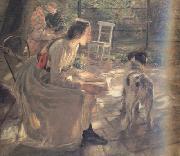 |
Fritz von Uhde
|
|
German, 1848-1911
was a German painter of genre and religious subjects. His style lay between Realism and .Uhde was born in Wolkenburg, Saxony. In 1866 he was admitted to the Academy of Fine Arts in Dresden, but later that year he left his studies for military service, and from 1867 to 1877 he was a professor of horsemanship to the regiment of the assembled guard. He moved to Munich in 1877 to attend the Academy of Fine Arts. In Munich he particularly admired the Dutch old masters, and in 1879 he travelled to Paris where his studies of the Dutch painters continued under Mihely Munkecsy's supervision. In 1882 a journey to Holland brought about a change in his style, as he abandoned the dark chiaroscuro he had learned in Munich in favor of a colorism informed by the works of the French Impressionists. His work was often rejected by the official art criticism, and by the public, because his representations of ordinary scenes were considered vulagar or ugly. The critic Otto Julius Bierbaum was more sympathetic; in 1893, he wrote, "As a painter of children, for example, Uhde is extraordinarily distinguished. He does not depict them as sweetly as used to be popular; in other words not as amusing or charming dolls, but with extreme, very strict naturalness." In about 1890, Uhde became a professor at the Academy of Fine Arts in Munich. |
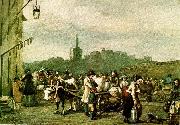 |
fritz von dardel
|
|
Fritz Ludvig von Dardel, född den 24 mars 1817 i Neuchâtel, död den 27 maj 1901 i Stockholm, var en schweiziskfödd svensk överintendent, militär, målare och tecknare.
Fritz von Dardel var son till godsägaren Georges-Alexandre von Dardel och grevinnan Hedvig Sofia Charlotta Amalia Lewenhaupt. Han var gift med friherrinnan Augusta Silfverschiöld. Släkten von Dardel kommer från Schweiz och adlades i Sverige 1810.
Von Dardel blev vid sexton års ålder konstapelkadett vid Vendes artilleriregemente, 1837 underlöjtnant vid Svea livgarde och avancerade till överstelöjtnant i armen 1862. Han blev 1850 adjutant hos kronprinsen och sedan hos Karl XV. Von Dardel var 1858-62 militärattach?? i Paris samt blev 1864 kabinettskammarherre hos Karl XV och samma år överintendent och ordföranden i Akademin för de fria konsterna, av vilken han 1861 invalts till hedersledamot. Dessutom var han ordförande i Nationalmuseums nämnd i 25 år (1867-92).
Vid flera konstutställningar i Europa (1867, 1871, 1873 och 1878) samt i Philadelphia (1876) var han juryman.
Själv hade von Dardel bedrivit studier på L??on Cogniets och E. Lamis ateljeer i Paris.
Fritz von Dardel tillhörde Karl XV:s intima krets och har gjort ett flertal dråpliga, akvarellerade teckningar av personer och händelser vid hovet eller under kungens resor, vidare folklivsbilder samt litografier. Hans dagböcker (se nedan) som utgavs postumt är skrivna på franska och översatta och redigerade av hans söner. |
 |
fritz thaulow
|
|
född 1847 i Christiania, död 5 november 1906, var en norsk målare. Han är en av de internationellt mest kända norska konstnärerna från 1800-talet.
Thaulow fick sin utbildning vid Konstakademin i Köpenhamn 1870 -72, och 1873-75 var han elev till Hans Gude i Karlsruhe. Åren efter detta uppehöll han sig för det mesta i Paris där han fick avgörande intryck från de franska impressionisterna.
1880 vände Thaulow hem som överbevisad naturalist. Tillsammans med Christian Krohg och Erik Werenskiold blev han snabbt en av ledarna i de unge konstnärernas kamp för en rikare och mer vidsynt norsk konstmiljö. Thaulow var bl.a. med på att etablera den första Höstutställningen 1882.
1892 slog han sig ner i Frankrike, och han besökte USA 1898. Från och med samma år bosatte han sig i Paris, där han blev en kändis och blev också känd internationellt, bl.a. genom att bli antagen till den prestigefulla Salongen. |
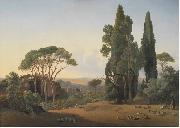 |
Fritz Petzholdt
|
|
(1 January 1805 - 29 August 1838) was a Danish landscape painter of the Copenhagen School, also known as the Golden Age of Danish Painting. He spent most of his artistic life in Italy, where he painted refined landscapes in a light colour palette but died early, most likely by way of suicide.
Fritz Petzholdt was born into a prosperous home on 1 January 1805 in Copenhagen to grocer Johan Jacob Petzholdt and his second wife Josephine Marie Elisabeth Petzholdt. After completing an apprenticeship as a house painter, he attended the Royal Danish Academy of Fine Arts from 1824 where he studied under Christoffer Wilhelm Eckersberg, known as the farther of the Golden Age of Danish Painting spanning the first half of the 19th century. He graduated in 1828 and already the following year sold a painting, En mose ved Høsterkøb med tørvearbejdere (A Bog at Høsterkøb), to the Royal Danish Painting Collection.
Although he never won the Academy's gold medal, the traditional opening for Academy students to go abroad to further their studies since it was accompanied by a travel stipend, his family's wealth allowed him to travel to Harz the same year and then, in May 1830, to set out for Rome. On the way he visited Dresden, Prague, Nuremberg, Munich, Venice and Florence. In Rome he joined the Danish artists colony which had formed in the city with Bertel Thorvaldsen as its centre. He made excursions to the Roman countrysideeto places such as Tivoli, Subiaco and Olevanoeas well as longer trips south to Naples, Sicily and Corfu.
In the winter of 1835/36 he returned to Copenhagen due to his farther's illness and subsequent death. Shortly after the funeral, he returned to Italy with an extended stop in Munich on the way. From Italy he continued to Greece, a destination only Martinus Rørbye had visited before him among the Danish Golden Age painters. On 29 August 1838 he was found dead in his hotel room in Patras with his throat cut. Whether it was a case of suicide or murder was never settled.
|
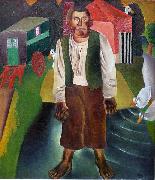 |
Frits Van den Berghe
|
|
(3 April 1883 - 22 September 1939) was a Belgian expressionist painter.
He was born at Ghent. Like his friends Constant Permeke and Gustave De Smet, he first adopted the late-impressionist style of Emile Claus, but converted to expressionism during World War I.
|
 |
Frits Thaulow
|
|
Norwegian Impressionist Painter, 1847-1906
.Norwegian painter and engraver. Originally wanting to become a marine painter he studied at the art academy in Copenhagen (1870-73) as well as with the Danish marine specialist C. F. S?rensen (1818-79). He spent two winters at Karlsruhe (1873-4, 1874-5) as the pupil of Hans Gude and then went to Paris, where he spent much of the period 1875-9. His marines and coastal pictures, some of which were accepted at the Paris Salon, were only moderately successful, but he acquired a fair knowledge of contemporary French Realist art and felt that Norwegian artists should learn from it. |
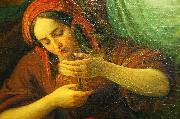 |
Friedrich Wilhelm Schadow
|
|
Friedrich Wilhelm Schadow (7 September 1789 - 19 March 1862) was a German Romantic painter.
He was born in Berlin and was the second son of the sculptor Johann Gottfried Schadow.
In 1806-1807 Friedrich served as a soldier. In 1810 he traveled with his elder brother Rudolph to Rome where he became one of the leaders among painters of the Nazarene movement. Following the example of Johann Friedrich Overbeck and others, he joined the Roman Catholic Church, and held that an artist must believe and live out the truths he essays to paint. The sequel showed that Schadow was qualified to shine more as a teacher and mentor than as a painter. As an author, he is best known for his lecture, Ueber den Einfluss des Christentums auf die bildende Kunst (About The Influence of Christianity On The Visual Arts) (Desseldorf, 1843), and the biographical sketches, Der moderne Vasari (Berlin, 1854).
In Rome, Schadow was given one of his first major commissions when the Prussian Consul-General, General Jakob Salomon Bartholdy, befriended the young painter, and asked him and three young compatriots (Cornelius, Overbeck and Veit) to decorate in fresco a room in his house on the Pincian Hill. The overall theme selected was the story of Joseph and his brethren, and two scenes, the Bloody Coat and Joseph in Prison, were conferred on Schadow. In 1819, Schadow was appointed professor in the prestigious Berlin Academy of the Arts, and his ability and thorough training gained many devoted disciples.
It was during this period that Schadow developed his paintings for churches. In 1826, Professor Schadow was made director of the Desseldorf Academy of the Arts, which he reoriented towards the production of Christian art, though he began a major dispute with one of its professors, Heinrich Christoph Kolbe, ending in the latter leaving the Academy in 1832. In 1837, Schadow selected, at request, those of his students best qualified to decorate the chapel of St Apollinaris on the Rhine with frescoes. When finished, they were acclaimed as the fullest and purest manifestation of the spiritual side of the Desseldorf school. One of his famous students, Heinrich Mucke, carried on the liturgical art with emphasis both in painting and frescoes. The painting of the "Wise and Foolish Virgins," considered one of his masterworks, was commissioned in 1842. Now in the Städel Museum, this large and important picture, while carefully considered and rendered, it however lacks power of some of his other works. |
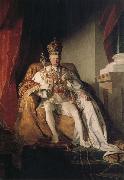 |
Friedrich von Amerling
|
|
Austrian Academic Painter, 1803-1887,Austrian painter. He came from a family of craftsmen and studied (1815-24) at the Akademie der bildenden Kenste, Vienna, where one of his teachers was the conservative history painter Hubert Maurer (1738-1818). From 1824 to 1826 he attended the Academy in Prague, where he was taught by Josef Bergler. In 1827 and 1828 Amerling stayed in London, and he met the portrait painter Sir Thomas Lawrence, whose work was to be a strong influence on Amerling's painting during the next two decades. Amerling also travelled to Paris and Rome but was recalled to Vienna on an official commission to paint a life-size portrait of the emperor Francis I of Austria (Vienna, Ksthist. Mus.). With this work, |
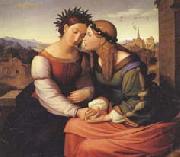 |
Friedrich overbeck
|
|
1789-1869
German religious painter. Expelled from the Vienna Academy because of his opposition to its classicism, he went to Rome and with Peter von Cornelius, Veit, Schadow-Godenhaus, and others, formed the group known as the Nazarenes. His first real successes were his frescoes for the Casa Bartholdy (now in Berlin) and for the Villa Massimo. Among his notable paintings are Christ's Entry into Jerusalem and Christ's Agony in the Garden. Overbeck sought to make his art serve religion. |
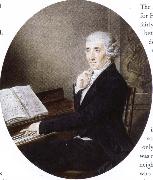 |
friedrich nietzsche
|
|
Period: Romantic (1820-1869)
Country: Germany
Born: October 15, 1844 in Röcken
Died: August 25, 1900 in Weimar |
 |
Friedrich Herlin
|
|
(c. 1425/30 - 1500) was a German painter. His earliest known work, depicting scenes from the Life of the Virgin, is dated 1459. A signature on an altarpiece in Nördlingen, dating it to 1462, identifies him as being from Rothenburg, as do citizenship documents from 1467. Nevertheless, it is possible that he lived there for only a short time, and that his origins lie in Ulm, where a painter named Hans Herlin lived and worked from 1449 until 1468. Stylistically, he borrowed much from Rogier van der Weyden, indicating a great deal of familiarity with the art of the Netherlands and of Cologne. The sculpture attached to the altarpiece of 1462, though officially listed as by the so-called "Master of Nördlingen", has been tentatively ascribed to Nicolaus Gerhaert, which if true would indicate extensive contacts to the highest artistic circles of the era.
Little else is known of Herlin, save that he died in Nördlingen in 1500.
|
 |
Friedrich Hagedorn
|
|
(23 April 1708 - 28 October 1754), German poet, was born at Hamburg, where his father, a man of scientific and literary taste, was Danish minister.
He was educated at the gymnasium of Hamburg, and later (1726) became a student of law at Jena. Returning to Hamburg in 1729, he obtained the appointment of unpaid private secretary to the Danish ambassador in London, where he lived till 1731. Hagedorn's return to Hamburg was followed by a period of great poverty and hardship, but in 1733 he was appointed secretary to the so-called "English Court" (Englischer Hof) in Hamburg, a trading company founded in the 13th century. He shortly afterwards married, and from this time had sufficient leisure to pursue his literary occupations till his death.
Hagedorn is the first German poet who bears unmistakable testimony to the nation's recovery from the devastation wrought by the Thirty Years' War. He is eminently a social poet. His light and graceful love-songs and anacreontics, with their undisguised joie de vivre, introduced a new note into the German lyric; his fables and tales in verse are hardly inferior in form and in delicate persiflage to those of his master La Fontaine, and his moralizing poetry re-echoes the philosophy of Horace. He exerted a dominant influence on the German lyric until late in the 18th century.
The first collection of Hagedorn's poems was published at Hamburg shortly after his return from Jena in 1729, under the title Versuch einiger Gedichte (reprinted by A. Sauer, Heilbronn, 1883). In 1738 appeared Versuch in poetischen Fabeln und Erzählungen; in 1742 a collection of his lyric poems, under the title Sammlung neuer Oden und Lieder; and his Moralische Gedichte in 1750. A collection of his entire works was published at Hamburg in 1757 after his death. The best is J.J. Eschenburg's edition (5 vols., Hamburg, 1800). Selections of his poetry with an excellent introduction in F. Muncker's Anakreontiker und preussisch-patriotische Lyriker (Stuttgart, 1894). See also H. Schuster, F. von Hagedorn und seine Bedeutung fer die deutsche Literatur (Leipzig, 1882); W. Eigenbrodt, Hagedorn und die Erzählung in Reimversen (Berlin, 1884).
|
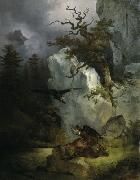 |
Friedrich Gauermann
|
|
(September 10, 1807 - July 7, 1862), Austrian painter, son of the landscape painter Jacob Gauermann (1773 - 1843), was born at Miesenbach near Gutenstein in Lower Austria.
It was the intention of his father that he should devote himself to agriculture, but the example of an elder brother, who, however, died early, fostered his inclination towards art. Under his father's direction he began studies in landscape, and he also diligently copied the works of the chief masters in animal painting which were contained in the academy and court library of Vienna. In the summer he made art tours in the districts of Styria, Tirol, and Salzburg.
Two animal pieces which he exhibited at the Vienna Exhibition of 1824 were regarded as remarkable productions for his years, and led to his receiving commissions in 1825 and 1826 from Prince Metternich and Caraman, the French ambassador. His reputation was greatly increased by his picture "The Storm," exhibited in 1829, and from that time his works were much sought after and obtained correspondingly high prices. His "Field Labourer" was regarded by many as the most noteworthy picture in the Vienna exhibition of 1834, and his numerous animal pieces have entitled him to a place in the first rank of painters of that class of subjects.
The peculiarity of his pictures is the representation of human and animal figures in connexion with appropriate landscapes and in characteristic situations so as to manifest nature as a living whole, and he particularly excels in depicting the free life of animals in wild mountain scenery. Along with great mastery of the technicalities of his art, his works exhibit patient and keen observation, free and correct handling of details, and bold and clear colouring. He died at Vienna on the 7th of July 1862.
Many of his pictures have been engraved, and after his death a selection of fifty-three of his works was prepared for this purpose by the Austrian Kunstverein (Art Union).
|
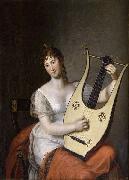 |
Friedrich Carl Groger
|
|
(14 October 1766, Plön - 9 November 1838, Hamburg) was a north-German portrait painter and lithographer. One of the most respected portraitists of his time in northern Germany, his works are to be found in several museums, including the Hamburger Kunsthalle, as well as in north German, Holstein and Danish private collections.
Gröger was the son of a tailor in Plön, where he grew up in modest circumstances. His parents wanted him to become a tailor or wood turner and opposed his early artistic activities. He was largely self taught in painting, though he had some contact in Lebeck with Tischbein and in 1785 was in the city of Lebeck, where he met Heinrich Jacob Aldenrath, his first, loyalest and lifelong friend - the Grögersweg in Hamburg-Barmbek named after him links the Tischbeinstraße with the Aldenrathsweg.
From 1789 he studied at Berlin's Akademie der Kenste. He and Aldenrath then went together to Hamburg, then on a joint study trip to Dresden and Paris, then back to Lebeck, where he worked until 1807. They then alternated between Hamburg, Copenhagen, Kiel and Lebeck, before finally settling in Hamburg in 1814. In 1792 Gröger was made an honorary member of the Gesellschaft zur Beförderung gemeinnetziger Tätigkeit in Lebeck.
Gröger developed from a miniature painter into a portrait painter, who towards the end of his life preferred three quarter bust portraits. Aldenrath took over the miniature painting side of their joint business. After lithography developed in northern Germany, they both worked in this medium individually as well as jointly under the business name Firma Gröger & Aldenrath.
|
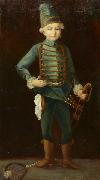 |
Friedrich August von Kaulbach
|
|
(2 June 1850, Hannover - 26 July 1920, Munich, Germany) was a German portraitist and historical painter. He was the son of Theodor Friedrich Wilhelm Christian Kaulbach (1822 - 1903), the court painter at Hannover, and the great nephew of Wilhelm Kaulbach, another prominent member of the Kaulbach family of artists. He learned to paint from his father, and later was a student of August von Kreling at Nuremberg. He sought to emulate the artist Hans Holbein. |
|

